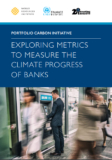
Bron
WRI
Banks are under pressure to disclose how their lending and investment activities affect global climate goals, but have struggled to choose the right metrics. New research provides insight into which metrics public- and private-sector banks can use, depending on asset class, to report on the extent to which their activities help or harm the transition toward a low-carbon economy.
The financial sector is increasingly aware of the need to shift capital flows away from companies and activities that contribute to the climate problem and into climate solutions. However, they are just getting started in thinking through and strategizing on how best to respond—and tracking the climate progress of financial institutions has proven notoriously challenging.
Are banks moving their financing in the right direction? It’s a very tough question to answer.
The analysis of 35 large development and commercial banks found that, by and large, banks are unable to convey their overall climate progress. Many that report on climate-friendly “green” investments, for instance, do not fill in the other half of the picture by also reporting on financing of activities and technologies that contribute significantly to GHG emissions, known as “brown” investments.
Until we know a financial institution’s contribution to the climate problem as well as their contribution to the climate solution, claims of climate progress can only be assessed as incomplete.



